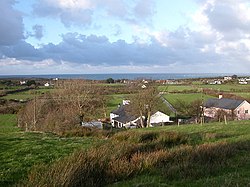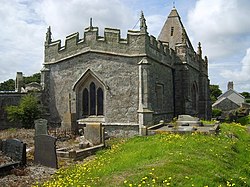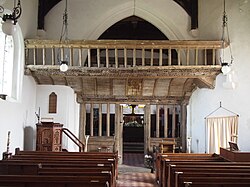Llaneilian: Difference between revisions
No edit summary |
m clean up, replaced: medieval → mediæval (2) |
||
| Line 17: | Line 17: | ||
==History== | ==History== | ||
===Llys Caswallon, Court of the Kingdom of Gwynedd=== | ===Llys Caswallon, Court of the Kingdom of Gwynedd=== | ||
The parish contains the remains of Llys Caswallon<ref name=GAT>{{watprn|GAT|3571|title=Llys Caswallon}}</ref> and there has been a traditional association of this site with the court of 5th-century [[Gwynedd|King of Gwynedd]] Cadwallon Lawhir ap Einion - the third generation of the dynasty of Gwynedd, being the grandson of Cunedda, the progenitor of the royal dynasty of Gwynedd. With no visible evidence above ground it had been thought that the site indicated on the Ordnance Survey map of 1889, within a field near Mynnydd Eilian, might be without basis and by the mid 20th century had been largely discredited as a Llys site.<ref name=GAT/> However a geophysical survey in 2009 identified foundations of a rectangular building within a trapezoidal enclosure, for which an early | The parish contains the remains of Llys Caswallon<ref name=GAT>{{watprn|GAT|3571|title=Llys Caswallon}}</ref> and there has been a traditional association of this site with the court of 5th-century [[Gwynedd|King of Gwynedd]] Cadwallon Lawhir ap Einion - the third generation of the dynasty of Gwynedd, being the grandson of Cunedda, the progenitor of the royal dynasty of Gwynedd. With no visible evidence above ground it had been thought that the site indicated on the Ordnance Survey map of 1889, within a field near Mynnydd Eilian, might be without basis and by the mid 20th century had been largely discredited as a Llys site.<ref name=GAT/> However a geophysical survey in 2009 identified foundations of a rectangular building within a trapezoidal enclosure, for which an early mediæval site was a strong possibility.<ref>{{cite web|url=http://www.walesher1974.org/her/groups/GAT/media/GAT_Reports/GATreport_858_compressed.pdf| title=The Ancient Landscape of Môn Archaeological Survey Project| issue=Report No 858| publisher=Cadw/Gwynedd Archaeological Trust|author=George Smith and David Hopewell| year=2010|page=35|accessdate=6 October 2017}}</ref> | ||
The Lineage of Cadwallon led to the famed reign of Rhodri the Great, who brought the kingdoms of Gwynedd, Powys and Seisyllwg under his control, and fought the threats of the Anglo Saxons and Vikings,<ref>[http://www.bbc.co.uk/wales/history/sites/themes/society/royalty_rhodrithegreat.shtml]</ref> and who was killed on the island of Anglesey in AD 854. Later, this lineage led to possibly the most well known of all the mediæval kings of Wales, Hywel Dda,<ref>[http://www.bbc.co.uk/wales/history/sites/themes/society/royalty_rhodrithegreat.shtml]</ref> who came to rule most of [[Wales]], and became synonymous with the codification of mediæval Welsh law which became famed for a reputation of justice and early recognition of women's rights. His legacy endured in the form of his laws, which remained in active use throughout Wales until the appointed date of implementation of the Laws in Wales Acts 1535–1542 of Henry VIII who asserted his royal descent by blood-line from the House of Aberffraw, via Rhodri Mawr via Hywel Dda. It was this claim to this ancient Brittonic lineage by a British monarch that led to a widespread feeling of the fulfilment of the myth of the Mab Darogan, a messianic figure of Welsh legend destined to reclaim Britain for the Celtic inhabitants. | The Lineage of Cadwallon led to the famed reign of Rhodri the Great, who brought the kingdoms of Gwynedd, Powys and Seisyllwg under his control, and fought the threats of the Anglo Saxons and Vikings,<ref>[http://www.bbc.co.uk/wales/history/sites/themes/society/royalty_rhodrithegreat.shtml]</ref> and who was killed on the island of Anglesey in AD 854. Later, this lineage led to possibly the most well known of all the mediæval kings of Wales, Hywel Dda,<ref>[http://www.bbc.co.uk/wales/history/sites/themes/society/royalty_rhodrithegreat.shtml]</ref> who came to rule most of [[Wales]], and became synonymous with the codification of mediæval Welsh law which became famed for a reputation of justice and early recognition of women's rights. His legacy endured in the form of his laws, which remained in active use throughout Wales until the appointed date of implementation of the Laws in Wales Acts 1535–1542 of Henry VIII who asserted his royal descent by blood-line from the House of Aberffraw, via Rhodri Mawr via Hywel Dda. It was this claim to this ancient Brittonic lineage by a British monarch that led to a widespread feeling of the fulfilment of the myth of the Mab Darogan, a messianic figure of Welsh legend destined to reclaim Britain for the Celtic inhabitants. | ||
| Line 27: | Line 27: | ||
[[File:Eglwys St Eilian from the rear - geograph.org.uk - 1409715.jpg||thumb|250px|St Eilian's church]] | [[File:Eglwys St Eilian from the rear - geograph.org.uk - 1409715.jpg||thumb|250px|St Eilian's church]] | ||
[[File:St Eilian's Church, Llaneilian rood loft.jpg|thumb|250px|15th-century rood screen and loft in St Eilian's church]] | [[File:St Eilian's Church, Llaneilian rood loft.jpg|thumb|250px|15th-century rood screen and loft in St Eilian's church]] | ||
Saint Eilian's Church is Grade-I listed.<ref>{{cite web| url = http://www.britishlistedbuildings.co.uk/wa-5275-chapel-of-st-mary-tal-y-llyn-and-churchyar|title= Chapel of St. Mary (Tal-y-llyn) and churchyard walls, Aberffraw| publisher = British Listed Buildings|accessdate = 11 January 2014}}</ref> A Celtic clas church, it has a 12th-century tower, 14th-century chapel and a nave and chancel dating from the 15th century. In the chancel is a 15th-century rood scree], and there are traces of post- | Saint Eilian's Church is Grade-I listed.<ref>{{cite web| url = http://www.britishlistedbuildings.co.uk/wa-5275-chapel-of-st-mary-tal-y-llyn-and-churchyar|title= Chapel of St. Mary (Tal-y-llyn) and churchyard walls, Aberffraw| publisher = British Listed Buildings|accessdate = 11 January 2014}}</ref> A Celtic clas church, it has a 12th-century tower, 14th-century chapel and a nave and chancel dating from the 15th century. In the chancel is a 15th-century rood scree], and there are traces of post-mediæval wall paintings. A painting of a skeleton bears the inscription ''"Colyn angau yw pechod"'' (the sting of death is sin).<ref>{{cite web|title=St Eilian's Church|url=http://www.coflein.gov.uk/en/site/32283/details/ST+EILIAN%27S+CHURCH%2C+LLANEILIAN/|work=Coflein|publisher=Royal Commission on the Ancient and Historical Monuments of Wales|accessdate=18 April 2013}}</ref> The Church is named after Saint Eilian (''Eilianus''). Eilian of Rome also known as Eilian of Anglesey was a 6th-century saint<ref>Great Synaxaristes: [http://www.synaxarion.gr/gr/sid/1717/sxsaintinfo.aspx O Aγιος Eϊλιανoς Eκ Ρώμης].'' 12 Ιανουαρίου. ΜΕΓΑΣ ΣΥΝΑΞΑΡΙΣΤΗΣ.</ref> who came from Rome to Britain where he lived as a hermit in the area north of Anglesey. His feast day is 13 January. The churchyard contains the war grave of a Royal Navy sailor of World War I.<ref>[http://www.cwgc.org/find-war-dead/casualty/670656/McGRATH,%20J] CWGC Casualty record.</ref> | ||
[[Point Lynas Lighthouse]] is located on the northern headland. The first lighthouse was built by the Mersey Docks and Harbour Board in 1779. It was replaced in 1835, and moved up onto the hilltop, so does not need a tower. It did not come under the care of [[Trinity House]] until 1973. By 2001 the lights were fully automated, so no resident staff were needed. whilst the light is retained in operational use, the building and associated lighthouse keepers cottages were returned to the Mersey Docks and Harbour Board who sold them to be a private home and holiday accommodation.<ref name=lynas>{{cite web|url=http://www.pointlynaslighthouse.com/the-lighthouse.php|title=Point Lynas Lighthouse| website=www.pointlynaslighthouse.com|author=Robin and Iona Beckmann|accessdate=25 September 2017}}</ref> | [[Point Lynas Lighthouse]] is located on the northern headland. The first lighthouse was built by the Mersey Docks and Harbour Board in 1779. It was replaced in 1835, and moved up onto the hilltop, so does not need a tower. It did not come under the care of [[Trinity House]] until 1973. By 2001 the lights were fully automated, so no resident staff were needed. whilst the light is retained in operational use, the building and associated lighthouse keepers cottages were returned to the Mersey Docks and Harbour Board who sold them to be a private home and holiday accommodation.<ref name=lynas>{{cite web|url=http://www.pointlynaslighthouse.com/the-lighthouse.php|title=Point Lynas Lighthouse| website=www.pointlynaslighthouse.com|author=Robin and Iona Beckmann|accessdate=25 September 2017}}</ref> | ||
Latest revision as of 09:45, 30 January 2021
| Llaneilian | |
| Anglesey | |
|---|---|

| |
| Location | |
| Location: | 53°24’35"N, 4°18’44"W |
| Data | |
| Post town: | Amlwch |
| Postcode: | LL68 |
| Local Government | |
| Council: | Anglesey |
| Parliamentary constituency: |
Ynys Môn |
Llaneilian is a hamlet and ancient parish in the Twrcelyn hundred of Anglesey. The hamlet covers the area between Amlwch and the beach at Port Eilian and includes Point Lynas lighthouse, a caravan park and an old church.
History
Llys Caswallon, Court of the Kingdom of Gwynedd
The parish contains the remains of Llys Caswallon[1] and there has been a traditional association of this site with the court of 5th-century King of Gwynedd Cadwallon Lawhir ap Einion - the third generation of the dynasty of Gwynedd, being the grandson of Cunedda, the progenitor of the royal dynasty of Gwynedd. With no visible evidence above ground it had been thought that the site indicated on the Ordnance Survey map of 1889, within a field near Mynnydd Eilian, might be without basis and by the mid 20th century had been largely discredited as a Llys site.[1] However a geophysical survey in 2009 identified foundations of a rectangular building within a trapezoidal enclosure, for which an early mediæval site was a strong possibility.[2]
The Lineage of Cadwallon led to the famed reign of Rhodri the Great, who brought the kingdoms of Gwynedd, Powys and Seisyllwg under his control, and fought the threats of the Anglo Saxons and Vikings,[3] and who was killed on the island of Anglesey in AD 854. Later, this lineage led to possibly the most well known of all the mediæval kings of Wales, Hywel Dda,[4] who came to rule most of Wales, and became synonymous with the codification of mediæval Welsh law which became famed for a reputation of justice and early recognition of women's rights. His legacy endured in the form of his laws, which remained in active use throughout Wales until the appointed date of implementation of the Laws in Wales Acts 1535–1542 of Henry VIII who asserted his royal descent by blood-line from the House of Aberffraw, via Rhodri Mawr via Hywel Dda. It was this claim to this ancient Brittonic lineage by a British monarch that led to a widespread feeling of the fulfilment of the myth of the Mab Darogan, a messianic figure of Welsh legend destined to reclaim Britain for the Celtic inhabitants.
World War I
In World War I a wireless telegraphy (radio) relay station at Llaneilian was used for communication with airships patrolling the Irish Sea for German submarines. Messages were forwarded by telephone to and from the airship base at RNAS Anglesey near Llangefni.[5]
Notable buildings


Saint Eilian's Church is Grade-I listed.[6] A Celtic clas church, it has a 12th-century tower, 14th-century chapel and a nave and chancel dating from the 15th century. In the chancel is a 15th-century rood scree], and there are traces of post-mediæval wall paintings. A painting of a skeleton bears the inscription "Colyn angau yw pechod" (the sting of death is sin).[7] The Church is named after Saint Eilian (Eilianus). Eilian of Rome also known as Eilian of Anglesey was a 6th-century saint[8] who came from Rome to Britain where he lived as a hermit in the area north of Anglesey. His feast day is 13 January. The churchyard contains the war grave of a Royal Navy sailor of World War I.[9]
Point Lynas Lighthouse is located on the northern headland. The first lighthouse was built by the Mersey Docks and Harbour Board in 1779. It was replaced in 1835, and moved up onto the hilltop, so does not need a tower. It did not come under the care of Trinity House until 1973. By 2001 the lights were fully automated, so no resident staff were needed. whilst the light is retained in operational use, the building and associated lighthouse keepers cottages were returned to the Mersey Docks and Harbour Board who sold them to be a private home and holiday accommodation.[10]
References
- ↑ 1.0 1.1 Llys Caswallon (ID PRN3571). in the 'Sites and monuments recor' for Gwynedd Archaeological Trust (GAT)
- ↑ George Smith and David Hopewell (2010). "The Ancient Landscape of Môn Archaeological Survey Project". Cadw/Gwynedd Archaeological Trust. p. 35. http://www.walesher1974.org/her/groups/GAT/media/GAT_Reports/GATreport_858_compressed.pdf. Retrieved 6 October 2017.
- ↑ [1]
- ↑ [2]
- ↑ Kenney, Jane; Flook, Roland; Diamond, Anita (March 2016). "First World War Military Sites: Manufacturing and Research and Development". Gwynedd Archeological Trust. pp. 14–15. http://www.walesher1974.org/her/groups/GAT/media/GAT_Reports/GATreport_1302_PtI.pdf. Retrieved 26 September 2017.
- ↑ "Chapel of St. Mary (Tal-y-llyn) and churchyard walls, Aberffraw". British Listed Buildings. http://www.britishlistedbuildings.co.uk/wa-5275-chapel-of-st-mary-tal-y-llyn-and-churchyar. Retrieved 11 January 2014.
- ↑ "St Eilian's Church". Coflein. Royal Commission on the Ancient and Historical Monuments of Wales. http://www.coflein.gov.uk/en/site/32283/details/ST+EILIAN%27S+CHURCH%2C+LLANEILIAN/. Retrieved 18 April 2013.
- ↑ Great Synaxaristes: O Aγιος Eϊλιανoς Eκ Ρώμης. 12 Ιανουαρίου. ΜΕΓΑΣ ΣΥΝΑΞΑΡΙΣΤΗΣ.
- ↑ [3] CWGC Casualty record.
- ↑ Robin and Iona Beckmann. "Point Lynas Lighthouse". http://www.pointlynaslighthouse.com/the-lighthouse.php. Retrieved 25 September 2017.